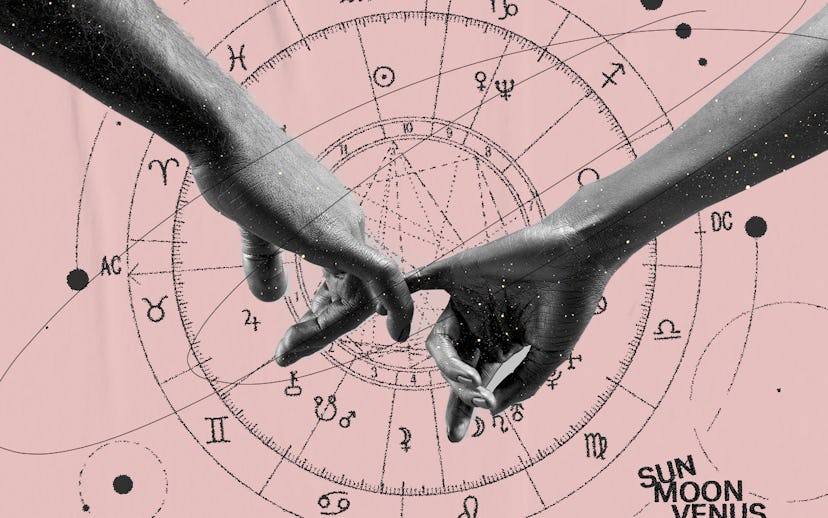
Astrology
An Astrologer’s Guide To Synastry
How to use astrology to map compatibility.
Tell anyone you’re a working astrologer — your barber, cab driver, butcher, or personal trainer — and they’ll all ask you the same question: Am I compatible with my partner? As with most cosmic inquiries, sun sign matches can give us a lot of information; if you’re a Pisces dating a Cancer, consult the Grimes-Elon case file and discuss with your spouse. But to really understand the complex dynamics between two people, you must go beyond sign-to-sign, and examine the matter chart-to-chart. Enter synastry, the art of contrasting and combining two charts to understand the gaps and connections in any relationship.
HOW SYNASTRY WORKS
Synastry takes two charts and overlays them, one atop the other, so that you can clearly see both of your respective planets and houses. With both charts in front of you, you can understand any planetary alignments or clashes, and get a sense of where and how you show up in one another’s lives. You can assemble a synastry chart at sites like Astro-seek. Be sure to ask your partner’s consent: peeking at someone’s birth data is as intimate — and potentially invasive — as it gets.
A synastry chart will feature one inner ring (that’s the first partner’s chart), followed by an outer ring (representing the second partner). Your work is to explore the correspondences between the planets and the houses. Sign comparison is indeed valuable here, but will likely only be adding flavor to the more firm variables: Where are all of your respective planets? How are they interacting? Are there clashes or unions? How do they manifest in different ways?
HOUSES
Start with houses: Where do your personal planets show up in your respective charts, and what can that tell you about your individual needs? You may have Mars in the fifth house of personal experience and creativity. We could intuit that you feel most embodied in some sort of athletic or physically generative capacity. Meanwhile, your partner’s Mars is in the twelfth house of inner processing; they may come into themselves behind the curtain, pursuing their own private creative projects in the studio. If they don’t want to join you for a jet skiing adventure, it’s not necessarily personal — it’s just not their thing.
With the charts transposed over one another, you can also consider where the planets show up between them. If, say, your partner has their Jupiter and sun aligning with your eighth house of sexuality and metamorphosis, we know that this relationship has been one of those transformative, possibly explosive vampiric duets — they light you up from the inside.
By viewing where your partner’s planets would sit in relation to your chart, you can understand how they show up for you. If their moon watches over your second house of earning and self-worth, then perhaps they reflect something about your identity, your values, and what you have.
PLANETS AND ASPECTS
You don’t really need to explore the relationship between your generational planets (Saturn, Uranus, Neptune, and Pluto) when it comes to synastry. The focus should be on the personal assortment: the sun, moon, Venus, Mercury, Mars and Jupiter. Venus and Mars are of particular importance, as they represent the dance between femininity and masculinity, reception and action, Psyche and Eros, creation and destruction. Look to their location and any other planetary interactions to see how you directly affect each other in the relationship.
The other planets are essential for understanding how your needs and means of self expression differ. How do you learn (Jupiter)? How do you communicate (Mercury)? Where do you shine (sun)? Where do you go dark (moon)? Consult our guide to aspect patterns in astrology for insight into how planets clash and align in a chart. This will be where it gets really interesting, when comparing two charts. What if you have an opposition between your respective Venuses? This indicates some polarity in the ways you receive love and affection. Perhaps your Mars and their Mercury are conjunct, which could indicate a smoking hot sapiosexual dynamic.
Be careful not to brand any inter-chart aspect as inherently negative or positive. A true astrologer views every aspect as a story worth telling — not a case to be closed. Use synastry as a means to surmount differences and understand subtleties, and not as a way to further enable your own neuroses. If well-honed, synastry can open up your partnership infinitely, awaken your compassion, and make it much easier to buy birthday gifts. Take your time. Get to know each other. Your charts aren’t going anywhere.